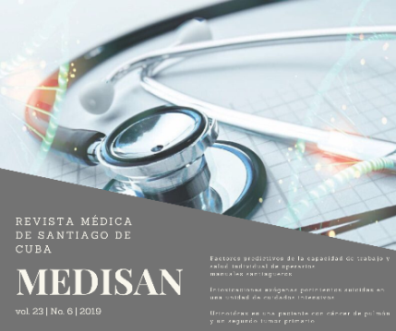Exogenous intoxications due to suicide attempts in an intensive care unit
Keywords:
exogenous intoxication, suicide attempt, psycho drugs, charcoal, Glasgow scale.Abstract
Introduction: The acute exogenous intoxications are as old as humanity.
Objective: To characterize the patients with acute exogenous intoxication attributable to suicide attempt.
Method: A descriptive and retrospective study of 26 patients with this diagnosis, assisted in the Intensive Cares Unit of Orlando Pantoja Tamayo Teaching General Hospital in Contramaestre,Santiago de Cuba, was carried out from January to December, 2017. The analyzed variables were: age groups, sex, occupation, toxics used by these patients,Glasgow scale at admission, use of charcoal and time of use, as well as type of treatment.
Results: In the series the 20-39 and 40-59 years patients prevailed, as well as the psycho drugs, followed by organophosphorus compounds, anti-inflammatory and histamine antagonists as the most used toxics. In more than half of those affected patients theGlasgow scale oscillated between 9 and 13 points. The gastric lavage and charcoal were the most used detoxification methods.
Conclusions: The exogenous intoxications constitute a true medical emergency, therefore, it is important to keep in mind the time between the accident and the treatment. The earlier the required medical intervention, the better will be the final prognosis of these patients; reason why the actions in the primary care level are determining.
Downloads
References
2. Muñoz Romo R, Borobia Pérez AM, Muñoz MA, Carballo Cardona C, Cobo Mora J, Carcas Sansuán AJ. Eficiencia en el diagnóstico y tratamiento de la intoxicación aguda por paracetamol: análisis de coste-efectividad a través de un programa de toxicovigilancia activa hospitalario. Emergencias. 2018 [citado 02/10/2018]; 30:169-76. Disponible en:
http://emergencias.portalsemes.org/descargar/eficiencia-en-el-diagnstico-y-tratamiento-de-la-intoxicacin-aguda-por-paracetamol-anlisis-de-costeefectividad-a-travs-de-un-programa-de-toxicovigilancia-activa-hospitalario/force_download/
3. Kemp AM, Clark MS, Dobbs T. Drogas de diseño: Cannabinoides sintéticos. Am J Med. 2016 [citado 02/10/2018]; 129 (3): 1-3. Disponible en: http://www.afam.org.ar/textos/drogas_de_diseno.pdf
4. Echeburúa E. Las múltiples caras del suicidio en la clínica psicológica. Ter Psicol. 2015 [citado 02/10/2018]; 33 (2). Disponible en: https://scielo.conicyt.cl/scielo.php?script=sci_arttext&pid=S0718-48082015000200006
5. Rosales García J, Quesada Castillo Y, Rodríguez Sánchez VZ, Naranjo Rodríguez Y, Pérez Brito G. Complicaciones severas por el uso parenteral del kerosene en intento de autólisis, a propósito de tres casos. Rev. Med. Electrón. 2013 [citado 02/10/2018]; 35 (5). Disponible en: http://scielo.sld.cu/scielo.php?script=sci_arttext&pid=S1684-18242013000500012
6. Bateman DN, Dear JW, Thanacoody HKR, Thomas SHL, Eddeleston M, Sandilands EA, et al. Reduction of adverse effects from intravenous acetylcysteine treatment for paracetamol poisoning: a randomised controlled trial. Lancet. 2014 [citado 02/10/2018]; 383 (9918): 697-704. Disponible en: https://www.ncbi.nlm.nih.gov/pubmed/24290406
7. Paulozzi LJ, Strickler GK, Kreiner PW, Koris CM. Controlled substance prescribing patterns - prescription behavior surveillance system, eight states, 2013. MMWR Surveill Summ. 2015 [citado 02/10/2018]; 64 (9): 1-14. Disponible en: https://www.ncbi.nlm.nih.gov/pubmed/26469747
8. Dolengevich Segal H, Rodríguez Salgado B, Mora Mínguez F, Quintero J. Trastornos por consumo de sustancias y fármacos. Medicine. 2015 [citado 02/10/2018]; 11 (86): 5137-43. Disponible en: https://dialnet.unirioja.es/servlet/articulo?codigo=5218477
9. Lajús Barrabeitg G. Drogas emergentes: conocimientos más relevantes. Revista del Hospital Psiquiátrico de la Habana. 2016 [citado 02/10/2018]. Disponible en: http://www.revistahph.sld.cu/sup%20esp%202016/drogas%20emergentes.html
10. Gárciga Ortega O. Adicciones y violencia. Prevención y tratamiento. La Habana: ECIMED; 2017 [citado 02/10/2018]. Disponible en: http://www.bvs.sld.cu/libros/adicciones_violencia_prevencion_ttmo/adicciones_y_violencia_prevencion_tratamiento.pdf
11. Garrido González I, Bugarín González R, Machín Fernández AJ. Consumo de drogas en estudiantes de enfermería. Enfermería Clínica. 2016 [citado 02/10/2018]; 26 (3): 174-80. Disponible en: https://www.clinicalkey.es/#!/content/playContent/1-s2.0-S1130862115001837?returnurl=https:%2F%2Flinkinghub.elsevier.com%2Fretrieve%2Fpii%2FS1130862115001837%3Fshowall%3Dtrue&referrer=
12. Brandenburg R, Brinkman S, de Keizer NF, Meulenbelt J, de Lange DW. In-hospital mortality and long-term survival of patients with acute intoxication admitted to the ICU. Crit Care Med. 2014 [citado 02/10/2018]; 42 (6): 1471-9. Disponible en: https://www.eapcct.org/publicfile.php?folder=congress&file=Abstracts_Malta.pdf
13. Baud F, Lamhaut L, Jouffoy R, Carli P. Asistencia circulatoria periférica en el curso de las intoxicaciones agudas: diez años de experiencia. Revista de la Sociedad Española de Medicina de Urgencias y Emergencias. 2016 [citado 02/10/2018]; 28 (4): 252-62. Disponible en: http://emergencias.portalsemes.org/descargar/asistencia-circulatoria-perifrica-en-el-curso-de-las-intoxicaciones-agudas-diez-aos-de-experiencia/force_download/
14. Díaz de Tuesta A, Usieto López L, Velilla Moliner J, Lahoz Rodríguez D. Intoxicación con dosis inusualmente altas de paracetamol. Revista Atalaya Médica. 2015 [citado 02 /10/2018]; 7: 45-50. Disponible en: http://atalayamedica.comteruel.org/index.php/revista/article/view/92/98
15. Urrego Novoa JR. Estudio descriptivo sobre la intoxicación por medicamentos durante los años 2010 y 2011 en Colombia. Revista Ciencia: Desarrollo e innovación. 2015 [citado 02 /10/2018]; 2: 2-7. Disponible en: https://mydokument.com/revista-ciencia-desarrollo-e-innovacion.html
16. Buffone I, Dejter M, Fortunatti E, García Elliot F, Irazabal C, Marlia R, et al. Caracterización de la consulta por intoxicación medicamentosa en los adolescentes en el Hospital Municipal de Bahía Blanca, Buenos Aires. Arch Argent Pediatr. 2018 [citado 02/10/2018]; 116 (4): 275-82. Disponible en:
https://www.sap.org.ar/docs/publicaciones/archivosarg/2018/v116n4a16.pdf
17. Zöhre E, Ayrik C, Bozkurt S, Köse A, Narcı H, Çevik I, et al. Retrospective analysis of poisoning cases admitted to the emergency medicine. Arch Iran Med. 2015 [citado 02/10/2018]; 18 (2): 117-22. Disponible en: https://www.ncbi.nlm.nih.gov/pubmed/25644801
18. Zamora A, Santofimio D. Intoxicaciones agudas en el Hospital Universitario de Neiva, Colombia, entre el 2005 y el 2010. Revista Facultad de Salud. 2010 [citado 02 /10/2018]; 2 (1): 59-69. Disponible en: https://journalusco.edu.co/index.php/rfs/article/download/30/34
19. Baud F, Lamhaut L, Jouffoy R, Carli P. Asistencia circulatoria periférica en el curso de las intoxicaciones agudas: diez años de experiencia. Emergencias. 2016 [citado 02 /10/2018]; 28 (4): 252-62. Disponible en: http://emergencias.portalsemes.org/descargar/peripheral-circulatory-support-in-acute-poisoning-10-years-experience/force_download/
20. Rios González CM, Toscano Ponce AG, De Benedictis Serrano GA, Guerra Tello MJ. Características clínicas y epidemiológicas de las intoxicaciones en el Hospital General Docente Ambato de Ecuador, 2013 a 2014. Rev. virtual Soc. Parag. Med. Int. 2018 [citado 02/10/2018]; 5 (1): 42-8. Disponible en: http://scielo.iics.una.py/scielo.php?pid=S2312-38932018000100042&script=sci_arttext&tlng=en
Published
How to Cite
Issue
Section
License
All the articles can be downloaded or read for free. The journal does not charge any amount of money to the authors for the reception, edition or the publication of the articles, making the whole process completely free. Medisan has no embargo period and it is published under the license of Creative Commons, International Non Commercial Recognition 4.0, which authorizes the copy, reproduction and the total or partial distribution of the articles in any format or platform, with the conditions of citing the source of information and not to be used for profitable purposes.





